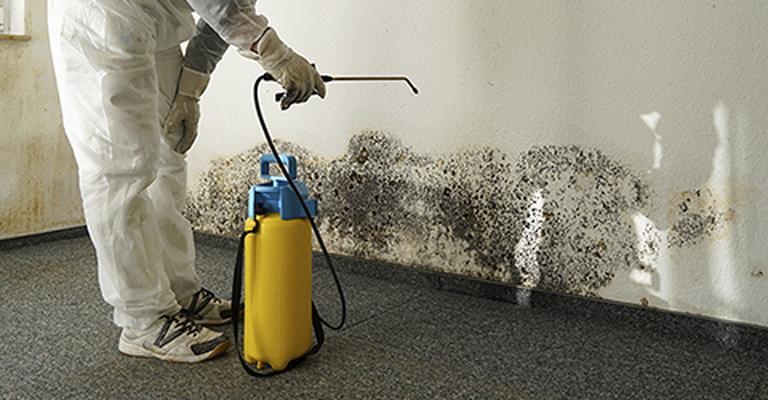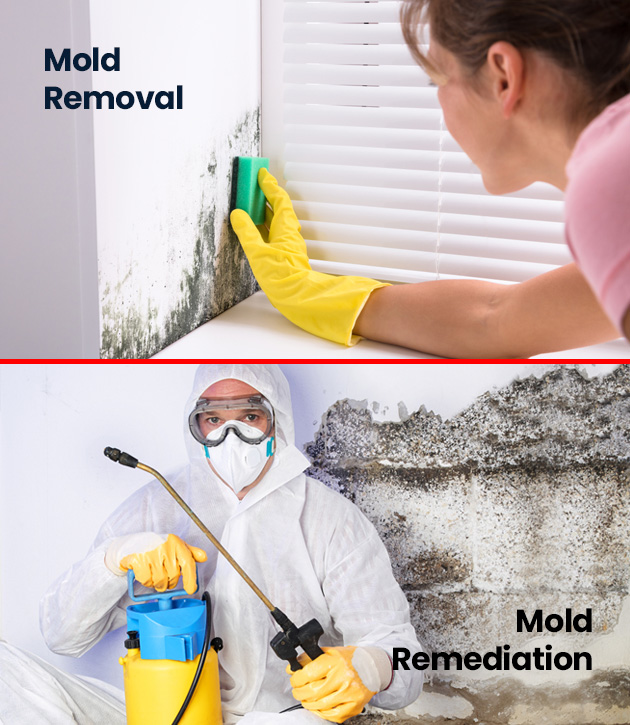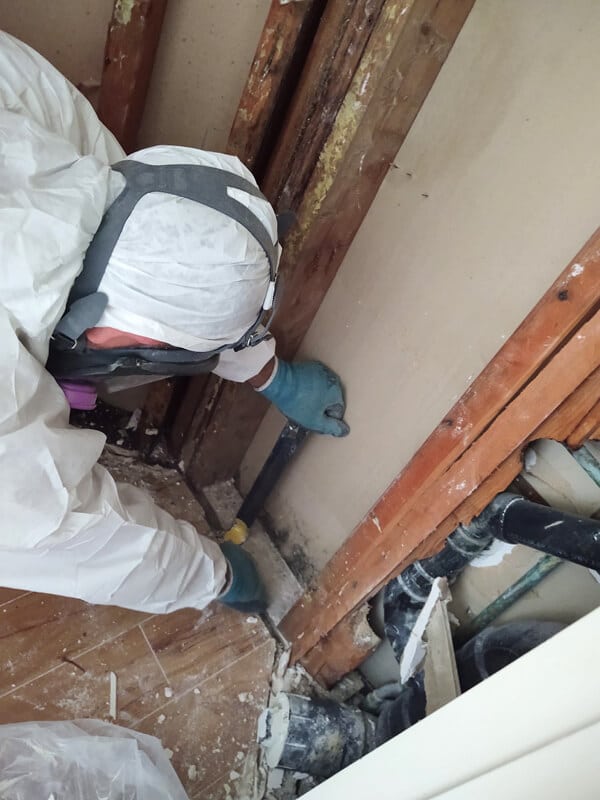If you’re dealing with mold growth in your home in San Diego, you may be wondering if it’s possible to tackle the issue on your own. Mold can be a serious problem, not only for the structural integrity of your property but also for your health. In this article, we’ll explore whether it’s advisable to attempt DIY mold removal in San Diego and what factors you should consider before taking on this task. So, before you dive into any home remedies or swift actions, let’s evaluate the risks and benefits to ensure you make an informed decision.

Risks of DIY Mold Removal
Lack of Training and Expertise
Attempting to remove mold yourself without proper training and expertise can be a risky endeavor. Mold remediation requires specific knowledge and skills to identify the type of mold, understand its growth conditions, and effectively eradicate it. Without this understanding, you may not be able to properly assess the extent of the infestation or choose the appropriate cleaning methods. This can lead to incomplete mold removal and the potential for mold regrowth.
Inadequate Tools and Equipment
Another risk of DIY mold removal is the lack of proper tools and equipment. Mold remediation often requires specialized tools and equipment, such as HEPA vacuums and commercial-grade cleaners, to effectively remove mold and prevent its spread. Without these tools, you may not be able to reach hidden mold or adequately clean contaminated surfaces. This can result in incomplete removal and the continued presence of mold in your environment.
Health Hazards
Improper handling of mold can pose significant health hazards. Certain types of mold produce allergens, irritants, and even toxins, which can cause a range of health problems. Common symptoms include respiratory issues, skin irritations, coughing, sneezing, watery eyes, and headaches. Without proper protection and containment measures, you may inadvertently expose yourself to these health hazards, putting your well-being at risk.
Mold Regrowth
One of the common challenges with DIY mold removal is the potential for mold regrowth. Without professional expertise, it can be difficult to completely eradicate mold, especially hidden mold within walls, ceilings, or other concealed areas. Mold spores are microscopic and can easily spread, leading to future growth if not properly addressed. If mold regrows after a DIY removal attempt, you may need to seek professional mold remediation to fully resolve the issue.
Understanding Mold
What is Mold?
Mold is a type of fungus that thrives in moist environments. It reproduces by releasing tiny spores into the air, which can then settle and grow on various surfaces. Mold can be found both indoors and outdoors, and it plays a vital role in the natural decomposition process. However, when mold growth occurs indoors, it can become a problem that requires remediation.
Common Types of Mold
There are various types of mold that can be found in homes and buildings. Some common types include:
- Stachybotrys chartarum (also known as black mold): This type of mold is often associated with water damage and can produce mycotoxins that are harmful to humans and animals.
- Aspergillus: Aspergillus is a common type of mold found in indoor environments. It can produce allergens and cause respiratory issues in sensitive individuals.
- Penicillium: Penicillium is often found in water-damaged buildings and can produce mycotoxins as well. It is known for its distinctive blue or green appearance.
- Cladosporium: Cladosporium is a type of mold commonly found on damp materials such as fabrics and wood. It can trigger allergic reactions in some people.
Mold Growth Conditions
Mold requires specific conditions to thrive and grow. These conditions typically include:
- Moisture: Mold needs moisture to grow, so areas with high humidity or water intrusion are often prone to mold infestation.
- Organic Matter: Mold can feed on organic materials such as wood, drywall, and carpeting. These materials provide a food source for mold spores to grow and reproduce.
- Darkness: Mold prefers dark environments and can thrive in areas with limited exposure to light.
- Lack of Ventilation: Poor ventilation can create stagnant air and moisture buildup, providing an ideal environment for mold growth.
Understanding these conditions can help you identify and address the factors contributing to mold growth in your home.
Signs of Mold Infestation
Visible Growth
One of the most obvious signs of mold infestation is the presence of visible mold growth. Mold can appear in various colors and textures, including black, green, white, or gray. It may appear fuzzy, slimy, or powdery, depending on the type of mold. If you notice any suspicious growth on walls, ceilings, floors, or other surfaces, it may indicate a mold problem that requires attention.
Musty Odor
Another telltale sign of mold infestation is a strong musty odor. Mold releases volatile organic compounds (VOCs) as it grows, which can create a distinct smell in the affected area. If you detect a persistent musty odor in your home, especially in areas where moisture is present or water damage has occurred, it is likely that mold is present and needs to be addressed.
Water Damage
Water damage is often a precursor to mold growth. If your property has experienced water leaks, flooding, or high humidity levels, it increases the likelihood of mold infestation. Areas that have suffered water damage, such as damp basements, leaky roofs, or burst pipes, should be checked thoroughly for signs of mold.
Health Symptoms
Health symptoms can also indicate the presence of mold in your environment. If you or your family members experience unexplained allergic reactions, respiratory issues, frequent headaches, or other health problems, it is important to consider the possibility of mold infestation. These symptoms may worsen when you are in specific areas of your home or improve when you are away, suggesting a mold-related issue.
Steps to DIY Mold Removal
Identify and Address Moisture Sources
The first step in DIY mold removal is to identify and address the moisture sources that are contributing to mold growth. Leaking pipes, water intrusion from outside, and poor ventilation are common culprits. Fixing any leaks, improving drainage, and implementing better ventilation can help prevent future mold problems.
Assess the Extent of Mold Infestation
Once moisture sources have been addressed, it is crucial to assess the extent of the mold infestation. This includes identifying both visible and hidden mold. Visible mold is easily recognizable, but hidden mold may require further investigation. Testing and sampling techniques can be employed to determine the extent of mold growth and the types of mold present.
Prepare Protective Gear and Equipment
Before starting the mold removal process, it is important to prepare the necessary protective gear and equipment. This includes respiratory protection, such as N95 masks, to prevent inhalation of mold spores. Protective clothing, gloves, and eye protection are also essential to minimize contact with mold. Additionally, gather cleaning supplies such as brushes, scrubbers, and mold-specific cleaning agents.
Containment and Isolation
To prevent the spread of mold spores during removal, it is crucial to establish containment and isolation measures. This involves sealing off the affected area using plastic sheets or barriers and covering surfaces and openings to prevent cross-contamination. Creating negative air pressure with the help of fans and air purifiers can further contain mold spores and prevent them from spreading to unaffected areas.
Removal and Cleanup
The actual removal and cleanup process involves drying out the affected area, physically removing visible mold, and cleaning the area thoroughly. HEPA vacuums should be used to capture and contain mold spores, and all surfaces should be scrubbed and disinfected. In some cases, it may be necessary to remove and dispose of mold-infested materials, such as drywall or carpeting, to ensure complete eradication.

Identifying and Addressing Moisture Sources
Leaking Pipes
Leaking pipes are a common source of moisture that can contribute to mold growth. Inspect your plumbing system regularly for leaks and fix any issues promptly. If you notice water stains or dampness around pipes, walls, or ceilings, it may indicate a leak. Repairing or replacing damaged pipes will help eliminate a potential source of moisture for mold.
Water Intrusion
Water intrusion from the outside can also create a favorable environment for mold growth. Check for signs of water seepage or leaks around windows, doors, roofs, and foundations. Ensure that these areas are properly sealed and maintained to prevent water from entering your home.
Poor Ventilation
Inadequate ventilation can trap moisture and increase humidity levels, creating an ideal breeding ground for mold. Ensure that your home has proper ventilation in areas prone to moisture, such as bathrooms and kitchens. Install exhaust fans and open windows when possible to promote air circulation and decrease humidity levels.
Assessing the Extent of Mold Infestation
Visible Mold
Visible mold growth can often give you an indication of the extent of the infestation. Carefully inspect all areas where mold is visible, including walls, ceilings, and floors. Take note of the size and spread of the mold patches to better understand the scope of the problem. Remember, visible mold is usually an indication of a larger issue that may require professional assistance.
Hidden Mold
Hidden mold can be more challenging to identify. It may be concealed behind walls, under flooring, or inside ceiling cavities. Look for signs of water damage, such as discolored or warped surfaces, as these can indicate the presence of hidden mold. If you suspect hidden mold but cannot locate the source, professional mold testing and sampling may be necessary.
Testing and Sampling
If you are uncertain about the extent of mold infestation or the types of mold present, testing and sampling can provide valuable information. Mold testing involves collecting air or surface samples and sending them to a laboratory for analysis. This can help determine the presence of mold spores, identify the types of mold, and provide a clearer picture of the mold problem in your home.

Preparing Protective Gear and Equipment
Respiratory Protection
Proper respiratory protection is essential during mold removal to prevent inhalation of mold spores. N95 masks or respirators with a higher filtration rating should be worn to ensure adequate protection. Make sure the mask fits securely and is properly sealed to prevent mold spores from entering your respiratory system.
Protective Clothing
Wearing protective clothing can minimize direct contact with mold and prevent skin irritations or allergic reactions. Disposable coveralls or clothing that can be easily washed and decontaminated should be worn during the removal process. Avoid wearing clothing made of porous materials that can easily trap mold spores.
Gloves and Eye Protection
Disposable gloves provide a barrier between your skin and mold, reducing the risk of exposure. Opt for gloves made of nitrile or latex to ensure proper protection. Eye protection, such as safety goggles, should also be worn to shield your eyes from mold spores and cleaning agents.
Cleaning Supplies
Gather the necessary cleaning supplies to effectively remove mold. This may include scrub brushes, scrubbers, sponges, and cleaning agents specifically formulated for mold removal. Look for products that contain ingredients like hydrogen peroxide or bleach, as these can help kill and inhibit the growth of mold.
Containment and Isolation
Sealing Off the Affected Area
Containment is crucial to prevent the spread of mold spores during the removal process. Use plastic sheets or barriers to seal off the affected area from the rest of the house. Ensure that all windows, doors, and vents are properly covered to minimize the risk of cross-contamination.
Covering Surfaces and Openings
Covering surfaces within the containment area can further prevent mold spores from settling on unaffected items. Use plastic sheets or tarps to cover furniture, flooring, or any other surfaces that cannot be removed from the area. This will make the cleanup process easier and reduce the chances of spreading mold during removal.
Creating Negative Air Pressure
Creating negative air pressure within the containment area is essential to contain mold spores and prevent them from spreading to other parts of the house. This can be achieved by using fans and air purifiers equipped with HEPA filters. The negative air pressure created by these devices helps to draw mold spores into the containment area and prevents them from escaping.

Mold Removal and Cleanup Techniques
Dry Mold and Cleaning
Before removing mold, it is essential to dry out the affected area. Use fans and dehumidifiers to reduce moisture levels and ensure that the area is adequately dried. Once dry, begin the cleaning process by scrubbing visible mold patches with a mold-specific cleaning agent. Thoroughly clean all affected surfaces, ensuring that no mold residue remains.
Removal of Mold-Infested Materials
In some cases, mold-infested materials may need to be physically removed and disposed of properly. Porous materials such as drywall, carpeting, or insulation can be difficult to fully clean and may harbor hidden mold. If these materials are extensively contaminated or cannot be effectively cleaned, it is best to remove and replace them to prevent further mold growth.
HEPA Vacuuming
HEPA (High-Efficiency Particulate Air) vacuums are designed to capture tiny particles, such as mold spores. Use a HEPA vacuum to thoroughly clean all surfaces in the affected area, as well as nearby areas that may have been exposed to mold spores. Vacuum upholstery, carpets, and other porous materials to remove any lingering mold spores.
Disinfection and Prevention
After removing visible mold and cleaning the affected area, it is important to disinfect and prevent future mold growth. Use a mold-specific disinfectant to treat the cleaned surfaces, ensuring that mold spores and residual mold are completely eliminated. Implement preventive measures such as improving ventilation, reducing humidity levels, and promptly addressing any water issues to minimize the risk of future mold infestation.
When to Seek Professional Mold Remediation
Extensive Mold Infestation
If the mold infestation is extensive, covering a large area or involving multiple rooms, it is advisable to seek professional mold remediation. Professionals have the expertise and specialized equipment necessary to effectively remove and remediate extensive mold infestations. They can also address hidden mold that may be difficult for an untrained individual to identify and remove.
Health Concerns
If you or your family members are experiencing persistent or severe health symptoms related to mold exposure, it is best to consult a professional. Certain individuals, such as those with respiratory conditions or weakened immune systems, are more susceptible to the adverse effects of mold. Professional mold remediation can ensure proper containment, removal, and prevention of mold to safeguard your health.
Structural Damage
If mold has caused structural damage to your property, it is essential to bring in professionals to assess and address the damage. Mold can compromise the integrity of building materials, such as wood or drywall, which may require repair or replacement. Professionals can identify and remedy structural issues while ensuring effective mold removal.
Lack of Resources or Time
Mold remediation can be a time-consuming and resource-intensive process. If you lack the necessary resources, such as appropriate tools and equipment, or if you do not have the time to devote to thorough mold removal, it may be best to leave it to the professionals. They have the experience and resources to efficiently handle the mold removal process, saving you time and ensuring a more effective outcome.
In conclusion, while DIY mold removal can be tempting, it is crucial to understand the risks involved. Lack of training and expertise, inadequate tools and equipment, health hazards, and the potential for mold regrowth are all factors to consider. However, if you decide to proceed with DIY mold removal, it is important to understand the steps involved, such as identifying and addressing moisture sources, assessing the extent of the infestation, preparing protective gear and equipment, containment and isolation measures, and the proper techniques for mold removal and cleanup. If the mold infestation is extensive, if there are significant health concerns, if there is structural damage, or if you lack the necessary resources or time, it is recommended to seek professional mold remediation assistance. Remember, the health and safety of yourself and your loved ones should always be a priority when dealing with mold infestation.
